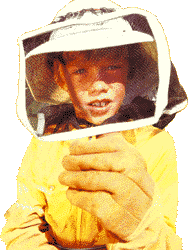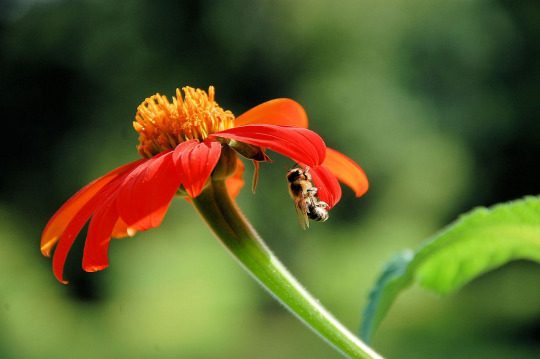Photo

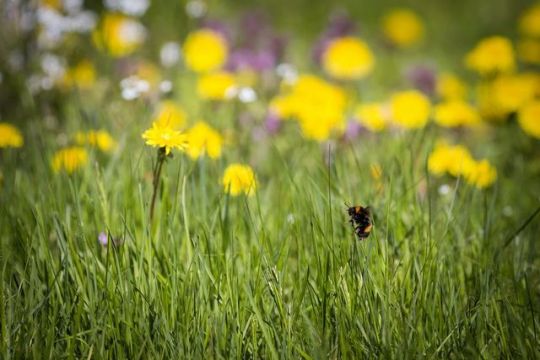
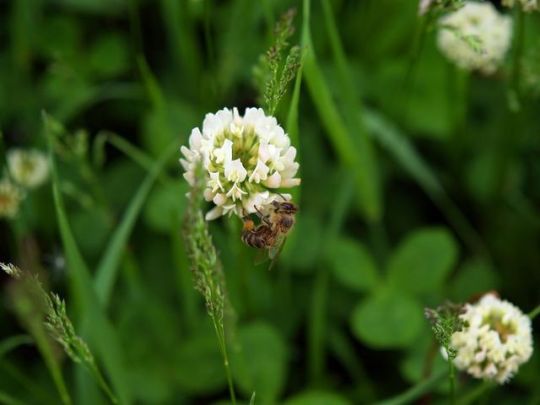
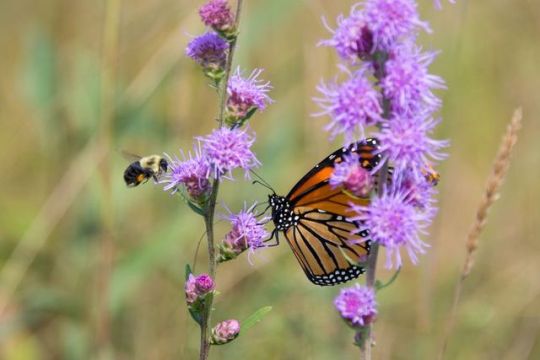
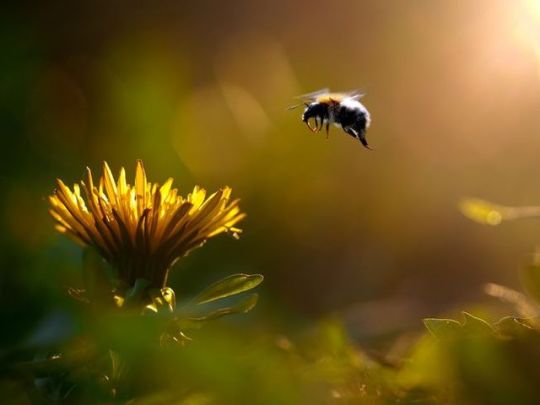
(via Why 'lazy' lawn mowers are heroes for bees | MNN - Mother Nature Network)
2 notes
·
View notes
Photo

(via How Do Bees Use Pollen - A Common Misconception - Carolina Honeybees)
Do Bees Eat Pollen?
Everyone knows that bees eat honey! We know that honey bees collect nectar from blooming plants. This plant nectar is converted into honey and stored by the bees for use during Winter.
The nectar to honey story is old news. Even most children understand that real honey comes from honey bees.
But bees eat something else as well! Bees need to consume pollen.
Do Bees Use Pollen to Make Honey?
Ok, this is the misconception. Because we know that bees have a great interest in pollen, some people think it is used to make honey. But no, bees do not directly use pollen to make honey. Honey is made from plant nectar. A hive full of pollen will not produce 1 ounce of honey. But there is more to the story…
[[More]]
Bees Collect Pollen From Flowers
Bees and pollen have a story to tell as well. Where does pollen come from ? Flowering plants use sweet nectar to attract honey bees and other pollinators. By moving particles of pollen from flower to flower, bees help the plants produce fruit. They don’t do this purposely of course. (Well – not as far as we know anyway :).
Pollination is very important to modern agriculture. Large fields of crops require many pollinators and honey bees fill that role very well. They live in large colonies and can be transported. Gardeners who live in areas without pollinators have to resort to desperate measure such as a "pollination wand." Can you imagine? It sounds funny but it is a serious problem.
How Bees Use Pollen
Surely it can not be that important ! What can this fuzzy dust do for honey bees? And its not just honey bees. Other bees, wasps and even spiders use pollen. Do bees eat pollen? Yes, once it has been mixed with enzymes and converted into bee bread.
Pollen plays a vital role in the life of bees. Without the benefits of pollen to bees and other insects, the colony would fail. Learn why bees collect pollen on their legs and return to the hive. And, how bees use pollen to grow their family.
Do Bees Use Pollen to Make Honey?
Again no, not directly but bees use pollen for another important job. Without pollen the colony would not be able to make honey because it would not have any workers to do the job!
Pollen is used to feed baby bees. It is the only protein source for the honey bee colony. Pollen is vital for the health and productivity of a honey bee colony. Without this protein source, no young bees could be raised. And it is important to have a variety of pollen sources for the young bees.
Watching bees carrying pollen from flower to flower is an enjoyable activity. Pollen can be very colorful. I enjoy watching the bees coming into the hive with a heavy load of pollen and trying to guess which plant was the source. I often see bright yellow pollen from dandelion flowers, pale green pollen from Red Maple and bright red from Henbit flowers.
Bees continue to need pollen during the cold months of the year. Brood rearing will slow down or stop for a while but some pollen will be used. Yes, even here in the South we have cold temps and the occasional snow storm. But, we also have warm days throughout the winter.
Our honey bees are blessed to leave the hive and fly on afternoons above 50 degrees. And my bees may find a very small amount of pollen from a blooming dandelion located in a warm corner.
Honey bees collect pollen during the warm months here in South Carolina to be used later. It is during the late winter and very early Spring that the stored pollen is most important. After months of little brood rearing activity our bees use pollen to raise young.
While Winter still rages outside the hive, brood rearing slowly begins. Stored pollen is eaten allowing nurse bees to feed brood. This food is essential for new bees. Even in the South, not much pollen is available for collection in late December/ early January.
Because pollen is not readily available when the bees start to rear brood, they rely on stored pollen. Any hive that fails to store extra pollen during the Fall is at risk. Nurse bees must consume bee bread (pollen and salvia,enzymes etc.) as a stimulus to produce royal jelly for very young bees.
Pollen – Not Just An Allergen
Sometimes pollen “gets a bad rap”. The itchy eyes and stuffy nose associated with pollen leaves us complaining about the yellow dust. However, pollen is viewed different by beekeepers. In fact, the fine pollen from wind-pollinated plants is the main culprit of your allergies. Honey bee prefer larger pollen particles.
How Do Bees Collect Pollen?
Bees collect pollen of different colors on their legs. In the hive, bees eat the pollen to provide food for young. A bee collecting red pollen. Bees use pollen as a protein source.
Pollen is a component of plant reproduction. In most cases it is necessary for seed development.
Some plants use the wind to transfer pollen from bloom to bloom, they dont need bees. Other flowers depend on pollinators such as bees, butterflies, moths, etc. to carry pollen.
A bee lands on a pollen producing flower. She wets the dry pollen with juices from her mouth and packs it onto the stiff hairs of the hind legs. (Sometimes pollen is sticky too !)
We call these hairs “pollen baskets”. She continues to pack pollen on her baskets until she is ready to return to the hive.
Sometimes pollen is collected accidentally. As the fuzzy honey bee is searching for nectar, dry pollen particles stick to her body and hitch a ride to the next flower.
Pollination Is An Accident
As bees transfer pollen inadvertently, the flowers are fertilized. But the bees are not intentionally pollinating flowers, they have another mission.
As mentioned earlier, pollen contains protein and other nutritious substances. Honey bees need protein to raise developing larvae (baby bees). All the honey/nectar in the world will not raise young bees without some pollen.
The healthiest bee colonies will harvest pollen from a variety of blooming plants. This practice helps them provide the most complete nutrition for the baby bees.
Bees Storing Pollen – Planning Ahead
Honey bees are designed by nature to store resources when they are plentiful. As the summer and fall grow to an end, the busy bees pack away nectar/honey to serve as food during winter. But as we see, it is not just nectar that is collected.
Fall is a major time when honey bees collect pollen. Bees continue to collect pollen until cold weather arrives. Especially in the early morning, you will see them working.
As they wet the pollen and packed it on their corbiculae (stiff hairs on the hind legs), they pay you little attention. You will see them working with extra energy as if they know Winter is coming.
I love to see a worker bee carrying pollen into the hive in October. This lets me know that the hives are preparing for winter. A smart beekeeper will check their colonies for pollen before winter sets in. A hot summer with little rain may result in low pollen storage.
Beekeepers Sometimes Help
If a honey bee colony is short on stored pollen, beekeepers can provide pollen substitutes.
This condition can happen during times of drought or other severe weather conditions.
How Bees Store Pollen
Pollen is a natural protein source full of nutrients and some moisture. It will spoil and degrade in nutritional value. The wondrous honey bee has a way to deal with that problem.
A worker bee brings pollen into the colony. Once inside, she goes to a honeycomb cell in a certain area of the comb near the nursery area. . She rakes the pellets off her hind legs into the cell. Using her front legs, she grooms all the pollen from her body. She solicits a drink of nectar from another house bee and returns to the field to collect more pollen. We must add one more step to the pollen storage procedure.
A worker house bee will firmly pack the pellets into the honeycomb cell. During packing, enzymes are added to the pollen. This process causes the pollen to undergo a lactic acid fermentation.
The end result will be a product that is less perishable and more easily digested by the bees. A small amount of honey is sometimes placed atop the pollen cell. We call the end product “bee bread”.
Nurse bees use pollen as a food source enabling them to feed young larva. Most of the pollen collected by the bees is eaten by older brood (over 3 days old) and young adults. The young adults (nurse bees) consume pollen to produce food from glands in their mouth for the youngest larva. As larva age their diet will change as well.
People Collect Bee Pollen Too
Sometimes beekeepers collect pollen to feed back to the bees during times of drought. The natural pollen must be stored properly to permit mold. This is not easy to do. That is why many of use rely on pollen supplement when I bees need them.
Many people also choose to consume bee pollen. It is believed that bee pollen contains many substances that promote good health. Proper collection methods are necessary to prevent mold due to the high moisture content of fresh pollen.
Whether collection is aimed at feeding bees or humans care must be taken. Beekeepers must collect carefully to avoid stressing the colony and causing a pollen shortage for the bees !
As an educational activity, I have collected pollen from my bee colonies. I was curious to learn what types of pollen my bees bringing to the hive. It is possible to identify pollen source by color. But there are so many pollen source out there it is not easy.
At local events, children (young and old) enjoyed touching and smelling the dried pollen. They are many educational opportunities involving the study of pollination.
I own a small plastic pollen trap exactly like the one pictured here. It is a little flimsy ! However for occasional use it performs well. Don’t even try to use the little gold hooks that come with it. I use a stretchy bungee cord and attach it to the front of the hive. I have had mine for many years and it is still functional.
Bees Use Pollen In Late Winter To Prepare For Spring
During late Fall in South Carolina, my honey bees have generally been taking a break for a few weeks. For most colonies, the queen has stopped laying eggs or at least only a small number. This is okay, we do not want the bees to be too populous. They might eat all their stores and starve before Spring.
As winter solstice passes and the daylight hours lengthen, a magical thing starts to happen inside the hive. The bees know spring is coming. The queen bee will start to lay a larger number of eggs each day. This gradual buildup will continue as the weeks progress.
Young bees need pollen for development at a time when there may not be pollen outside to collect. Thankfully , the numerous bees collecting pollen last fall have some in storage to use. If the colony experienced a large pollen deficiency , the colony may be in trouble. Late winter/early spring days can be windy and cool. Some trees (red maple) may produce pollen during winter but the weather may not allow flight.
Bee collect pollen from trees and flowers that bloom. Pollen is used by bees to raise young. Bees use pollen to raise young. They are collecting a pollen substitute in my homemade pollen feeder.
Beekeepers Help Colonies Lacking Pollen
This is an opportunity for a beekeeper to provide pollen for hungry bees. Some beekeepers collect and store natural pollen to give back to their bees during times of need. I think this is great.
However, I’m very concerned about proper storage of fresh pollen. It molds easily if not stored properly and I am not as good at making bee bread as a worker bee. Moldy pollen is a bad thing. Beekeepers who collect fresh pollen often use a food dehydrator to dry it for storage.
A well tested pollen supplement is the easiest way to provide pollen to your bees for most beekeepers. I have tried several formulas and my current favorite is “Mega Bee”. Mega Bee comes as a dry yellow powder . Another good choice is Bee-Pro from Mann Lake.
A protein patty is made with it using honey or syrup for use inside the hive. Or you can feed it to the bees dry. I prefer the dry feed method. This time of year, I always put a couple of cups of pollen sub outside in a protected place.
Bees Collecting Pollen From My Feeder
I really wanted one of those nifty pollen feeders but they cost $100. So, I found one of my empty Tidy Cat Plastic litter pails, washed & dried it thoroughly and hung it up under my shed. Your dry pollen sub must be protected from rain.
By late afternoon, the bees were having a wonderful time. I enjoyed watching them for a few minutes. The busy bees collecting pollen were not concerned about me watching. Their focus was on the job.
I was able to stand very close and watch them roll around in the powdery substance. Then each worker would groom herself making ready for flight. Away they would go back toward the bee yard, little yellow pollen pellets on their hind legs.
While looking through those seed catalogs, choose a few pollen producing flowers. If you have honey bees in your area, this can be a great activity for the family. However, be sure to place the pollen bucket well away from your home or play area as it will be buzzing for a few hours.
Happy Bee Lovin’ – Beekeeper Charlotte
3 notes
·
View notes
Photo
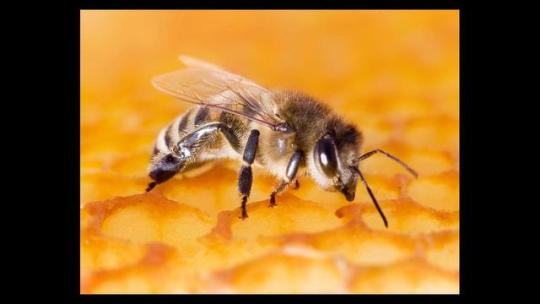
(via Why That Bee Sting Might Be Good for You | Science | AAAS)
Allergy sufferers, rejoice. Two new studies suggest that your sneezing and wheezing may actually protect you. Researchers report that mice that develop an allergic response to the venom in honey bee stings are more likely to survive potentially lethal doses of the same venom later on. The findings show that allergy can be beneficial and reveal some of the molecular machinery at work, but experts say the implications for humans are still unclear. In humans and other mammals, the immune system fends off unfamiliar and potentially harmful substances, such as viruses or toxins, in one of two ways. The so-called “type 1” reaction responds to viruses, bacteria, and other microbes by destroying them, while the “type 2” reaction uses an array of symptoms—including sneezing, coughing, and diarrhea—to expel allergens from the body. Because the type 2 response and the antibody it produces, immunoglobulin E (IgE), have been associated with resistance to worm infections, many scientists think that they evolved to protect against parasites (as opposed to microbes) but that they have no modern-day protective purpose. In the parasite-free developed world, they run rampant, reacting to benign substances such as pollen or peanuts with annoying or, in the case of anaphylactic shock (an extreme allergic reaction that can cause severe swelling and difficulty breathing), life-threatening consequences. Or so the prevailing theory goes. But pathologist Stephen Galli of the Stanford University School of Medicine in Palo Alto, California, thought type 2 responses had gotten a bad rap. To explore the effects—and tease out potential benefits—of type 2 reactions, he and his colleagues exposed mice to a common allergen: honey bee venom. They administered a dose of the venom—about as much as found in one or two bee stings—to two strains of mice: a type 1 response-prone strain and a type 2 response-prone strain. Two control groups of the same strains received no injections. Regardless of their predisposition to type 1 or 2 reactions, both of the “stung” mouse groups showed a type 2 response, ramping up their production of IgE antibodies specific to the venom. Then, 3 weeks later, the researchers gave all the mice a potentially lethal dose of the venom and waited to see what would happen. “It was an answer an allergist wouldn’t expect,” Galli says. “The second time around, the mice were protected.” Eighty-six percent of the type 1-prone mice that had had an allergic reaction survived the dose, versus only 7% of the mice that weren’t allergic. Among the type 2-prone mice, 80% of the allergic mice survived, whereas only 28% of the nonallergic mice did. The scientists saw a similar protective effect when they repeated the experiment using snake venom, which contains some of the same allergens found in bee venom. The antibodies protected the mice even when the rodents hadn’t produced them. Injecting IgE-deficient mice with venom-specific IgE-rich blood serum was sufficient to confer protection, Galli says. And repeating the experiment in mice lacking IgE or the ability to respond to it showed no protective effect. The results suggest that type 2 responses may have evolved to protect against venoms as well as parasites and that they’re still serving this function, the team reports today in the journal Immunity. The defense mechanism might have helped humans survive in the challenging conditions in which we evolved, Galli says. “We spent a long time encountering venomous insects and reptiles, and it’s likely that this defense mechanism made that possible.” In a separate study also published today in Immunity, immunologist Ruslan Medzhitov of the Yale University School of Medicine and colleagues confirm that mice with a previous type 2 response to bee venom have a greater resistance to potentially lethal doses of the stuff later on and that IgE-lacking mice miss out on this protective effect. What’s more, the team tracked down the venom ingredient that triggers the allergy—an enzyme called PLA2 that damages cell membranes and is found in the venoms of snakes, spiders, and many other creatures. The researchers worked out each step in the chain of events that leads to the type 2 reaction. The immune system sends out a surge of chemical messengers called cytokines to repair the damage done by PLA2, and that activates the type 2 response, Medzhitov says. “As far as I know, this is the first direct evidence that IgE-mediated responses can be protective and beneficial,” Medzhitov says. “It’s like the sensation of pain: It’s very unpleasant, but very important for our protection.” “These are very compelling, excellent studies,” says immunogeneticist Kathleen Barnes of Johns Hopkins University in Baltimore, Maryland, who was not involved in either study, “but we need to exercise caution in applying these findings in humans.” Human type 2 responses pose a number of mysteries, she says. It is unclear, for example, whether people with strong type 2 responses, who are prone to allergies, enjoy stronger resistance to venoms than the rest of us, or why type 2 response can cause life-threatening symptoms in certain individuals. The studies offer important new information, but leave these questions unanswered, she says. Immunologist Fred Finkelman of the University of Cincinnati College of Medicine in Ohio agrees. “Together, these studies round out our understanding of the evolution of the allergic response,” he says. “But this is more the beginning of the story than the end of it.”
1 note
·
View note
Photo

(via Woman dies from bee sting therapy promoted by Gwyneth Paltrow)
A woman died in Spain after suffering an allergic reaction while undergoing live bee acupuncture - an alternative therapy promoted by Gwyneth Paltrow in which the patient is stung by the angered insects. The 55-year-old woman had been undergoing the controversial treatment once a month for two years when she suddenly developed a severe reaction, according to a report by Spanish doctors. She “developed wheezing, dyspnea, and sudden loss of consciousness immediately after a live bee sting,” the report, published in the latest issue of the Journal of Investigational Allergology and Clinical Immunolog, said. The woman, whose identity has not been revealed, was taken to the Ramón y Cajal University Hospital in Madrid but died some weeks later of multiple organ failure. She had suffered a “massive watershed stroke and permanent coma” due to severe anaphylactic shock, said the report’s authors, Ricardo Madrigal and Paula Vázquez Revuelta of the hospital’s allergy unit. The 2015 case is believed to be the first reported death from live bee acupuncture - also known as bee venom apitherapy - of a patient who had previously not been allergic. The report said that repeated exposure to the allergen increased the risk of a severe reaction. Apitherapy involves a practitioner placing bees on the patient's body and angering them by pinching their head until the sting emerges. The venom can also be administered by injection. The treatment, which has been popularised in recent years by celebrities such as Paltrow, who founded the alternative lifestyle website Goop, was given to the Spanish woman at an unidentified clinic which offered it for muscular contractions and stress. The centre did not have adrenaline on site so treatment was delayed until an ambulance arrived 30 minutes later, the report said. The doctors warned that while some benefits of apitherapy had been reported, published evidence of its effectiveness and safety was “limited and scarce”. Treatments were being performed by private clinics and non-medical practitioners without the facilities or training to deal with anaphylaxis, they said. “The risks of undergoing apitherapy may exceed the presumed benefits, leading us to conclude that this practice is both unsafe and unadvisable,” the authors cautioned. Paltrow told the New York Times in 2016 that she was a fan of the “painful” treatment - a form of which was first used by the Ancient Greeks - claiming its effects were “pretty incredible”. In 2017 the British actor Gerard Butler revealed how he had gone into anaphylactic shock after being injected with the venom of 23 bees in a bid to tackle muscular problems.
0 notes
Photo
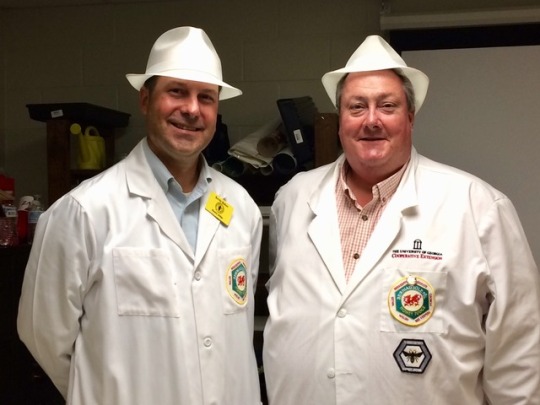
Judging a honey show for the Lake Country Beekeepers Association in Putnam County, GA
0 notes
Link
A honey bee is approximately a half of an inch long. Though tiny, it is made up of many complicated and interesting parts. The honey bee is one of the most streamline designs of any creature. Each part is tailored to a specific purpose, and does that purpose well.
0 notes
Text
So, you want to be a Beekeeper?
Sir Edmund Hillary (left) was a beekeeper with his brother Rex (not pictured). Since this was mainly a summer occupation, he had the time to climb mountains in the winter months.
0 notes
Text
Bottom Line Up Front (BLUF)
Almost anyone can become a Beekeeper with little to no help. It costs about $300 to get started with one hive. You can save money by assembling your own equipment and/or purchasing locally to save shipping costs. The time commitment for keeping one hive can be as little as an hour per week.
Pie In The Sky (PITS)
With a little experience, knowledge and help from local beekeepers who are typically generous with their time, you can become full blown Beekeeper. It’s a significant investment, but you can recoup some if not all the money you spend through sales of honey, candles and other crafts. In the process, Beekeeping could change your life.
0 notes
Text
The Benefits of Beekeeping
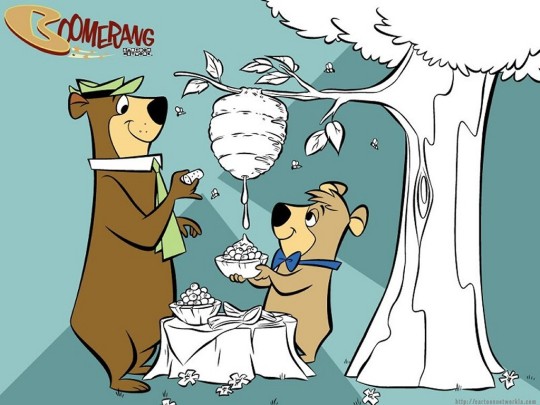
Honey production is not the only reason to keep bees. Without bees, many commercial crops would suffer serious declines. Even backyard beekeepers will likely enjoy some improvement in their garden's yield: more and larger fruits, flowers, and vegetables. Beekeeping opens up a whole new perspective to your knowledge of the environment, agriculture and the food industry.
Harvesting honey and beeswax from your beehives

How much honey can you expect? The answer to that question varies depending on the weather, rainfall, and location and strength of your colony. Don't expect to harvest any surplus honey in the first year a colony is established, but it is not unusual for a strong colony to produce 30 to 60 pounds of surplus honey per year. Processing honey from hive to jar does not require special equipment. You can bottle your own honey without an extractor.
Recognizing the value of bees as pollinators
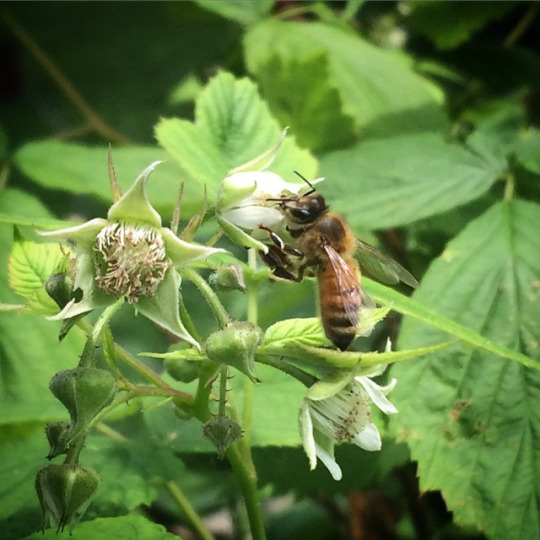
Any gardener recognizes the value of pollinating insects. Various insects perform an essential service in the production of seed and fruit. The survival of plants depends on pollination. Up to sixty percent of the fruits and vegetables we rely on to feed our families need honey bee pollination. The value of honey bee pollination to U.S. agriculture is more than $14 billion annually, according to a Cornell University study.
Saving the bees
In many areas, millions of colonies of wild (or feral) honey bees have been hurt by urbanization, pesticides, parasitic mites, and the recent phenomenon called "Colony Collapse Disorder" (CCD). Collectively, these challenges are devastating the honey bee population, but backyard beekeeping is helping to improve the situation.
Getting a bee education
As a beekeeper you continually discover new things about nature, bees, and their remarkable social behavior. Just about any school, nature center, garden club, or youth organization loves for beekeepers to share their knowledge. Spreading the word to others about the value these little creatures bring is great fun. Many beekeepers enjoy passing the knowledge to the next generation of beekeepers.
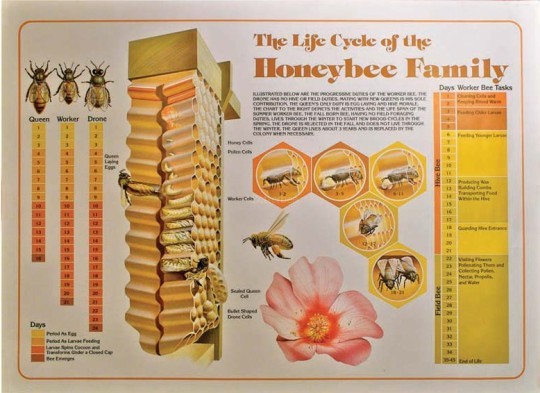
Improving your health: Bee therapies and stress relief
There’s something about being out there on a lovely warm day, the intense focus of exploring the wonders of the hive, and hearing that gentle hum of contented bees that reduces stress.
Any health food store proprietor can tell you the benefits of the bee products. Honey, pollen, royal jelly, and propolis have been a part of healthful remedies for centuries. Honey and propolis have significant antibacterial qualities. Royal jelly is loaded with B vitamins and is widely used overseas as a dietary supliment. Pollen is high in protein and can be used as a homeopathic remedy for seasonal pollen allergies.
Apitherapy is the use of bee products for treating health disorders. Even the bees’ venom plays an important role here — in bee-sting therapy. Venom is administered with success to patients who suffer from arthritis and other inflammatory/medical conditions. This field of study and treatement has become a science in itself and has been practiced for thousands of years in Asia, Africa, and Europe.
How to Know if You’d Make a Good Beekeeper

How do you know whether you’d make a good beekeeper? Is beekeeping the right hobby for you? Here are a few things worth considering as you consider beekeeping as a honey-producing pastime.
Beekeeping environmental considerations
Bees are remarkable creatures that do just fine in a wide range of climates.
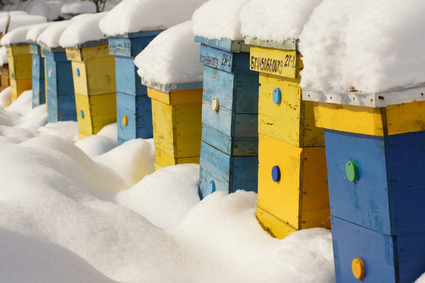
Beekeepers can be found in areas with long cold winters, in tropical rain forests, and in nearly every geographic region in-between. If flowers bloom in your part of the world, you can keep bees.
You don’t need much space. Beekeepers in Manhattan have a hive or two on their rooftops or terraces. Keep in mind that bees travel miles from the hive to gather pollen and nectar. They’ll forage an area as large as 6,000 acres, doing their thing. So the only space that you need for your bees is enough to accommodate the hive itself.
Zoning and legal restrictions related to beekeeping
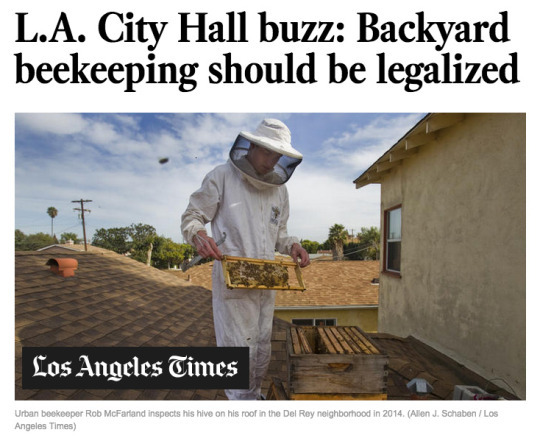
Most communities are quite tolerant of beekeepers, but some have local ordinances that prohibit beekeeping or restrict the number of hives that you can have. Some communities let you keep bees but ask that you register your hives with the local government. Check with your town hall, local zoning board, or state agricultural experiment station to find out about what’s okay in your neighborhood.
0 notes
Text
Beekeeping costs and equipment
What does it cost to become a beekeeper? All in all, beekeeping isn’t a very expensive hobby. You could invest about $200 for the beehive, equipment, tools, etc. For the most part, these are one-time expenses. In addition, you’ll spend $75 to $150 for a package of bees and queen, or a nucleus hive (“nuc” for short). Keep in mind the potential to offset some of your cost by selling honey. Your hive can give you 30 to 60 pounds of honey every year. At $5 to $7 a pound, that could give you an income of $150 to $400 per hive.

Mann Lake 10-Frame Traditional Basic Starter Kit, Painted Wood-Frames, 9-5/8-Inch $213.95 Amazon Prime
How many beehives do you need?
Most beekeepers start out with one hive, and that’s probably a good way to start your first season. Most beekeepers soon wind up getting a second hive.
"Two hives are better than one: If you’re starting off small, at least start a pair of hives. Different queens have different attitudes, different hives produce differently and you can compare how they both perform. Plus, if one hive leaves or fails, you can split the surviving one and repopulate the empty one."
What kind of honey bees should you raise?

The honey bee most frequently raised by beekeepers in the United States today is European in origin and has the scientific name Apis mellifera. Of this species, the most popular bee is the so-called “Italian” honey bee. These bees are docile, hearty, and good honey producers. They are a good choice for the new beekeeper.
Time and commitment for beekeeping
Beekeeping isn’t labor intensive. Sure you’ll spend part of a weekend putting together your new equipment. But the actual time that you absolutely must spend with your bees is surprisingly modest. Other than your first year you need to make only eight to ten visits to your beehives every year. Add to that the time that you spend harvesting honey, repairing equipment, and putting things away for the season, and you’ll probably devote 35 to 40 hours a year to your hobby (more if you make a business out of it).
Beekeeper personality traits
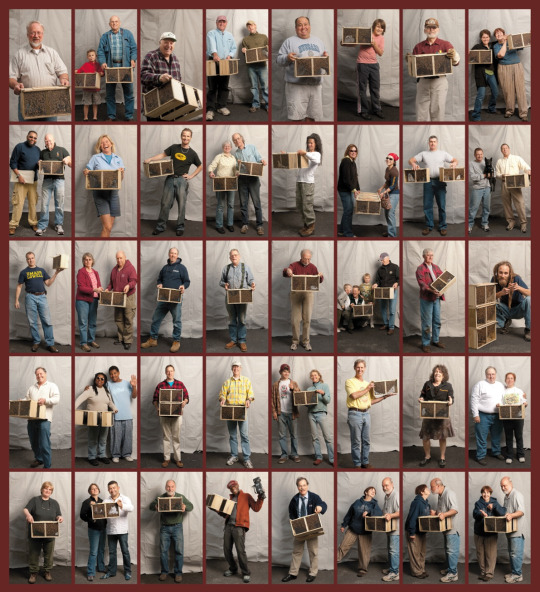
If you run every time you see an insect, beekeeping will be an uphill challenge for you; But if you love animals, nature, and the outdoors, and if you’re curious about how creatures communicate and contribute to our environment, you’ll be captivated by honey bees. If you like the idea of “farming” on a small scale, or you’re intrigued by the prospect of harvesting your own all-natural honey, you’ll enjoy becoming a beekeeper.
Allergies to bee stings
If you’re going to become a beekeeper, you can expect to get stung once in a while. But, when you adopt good habits as a beekeeper, you can minimize or even eliminate the chances that you’ll be stung.
All bee stings can hurt a little, but not for long. It’s natural to experience some swelling, itching, and redness. These are normal (not allergic) reactions. Some folks are mildly allergic to bee stings, and the swelling and discomfort may be more severe. The most severe and life-threatening reactions to bee stings occur in less than 1 percent of the population. If you’re uncertain, check with an allergist, who can determine whether you’re among the relatively few who should steer clear of beekeeping.
0 notes
Text
Or, Build Your Own Equipment...
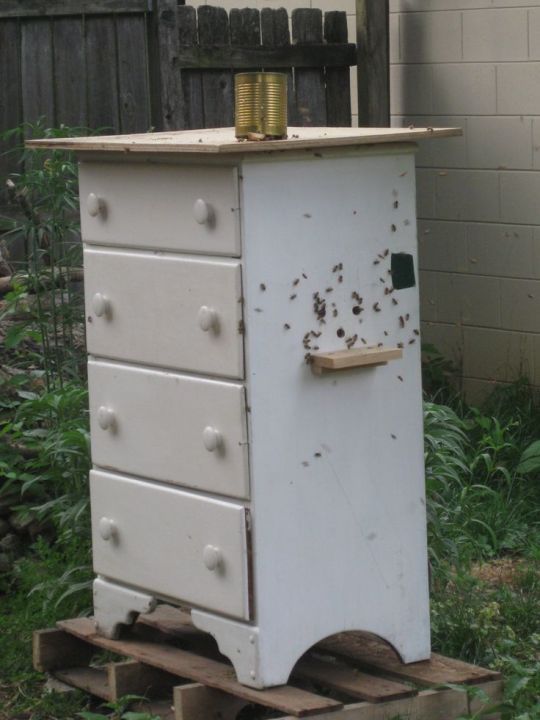
Chest of drawers beehive
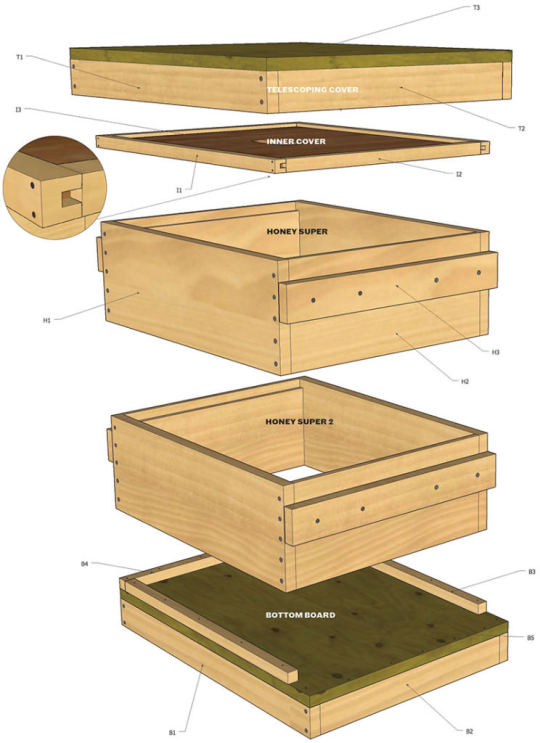
Click to follow link about building your own hives. Illustration by Cam Pauli
0 notes
Text
How to Order Beehive Kits and Parts
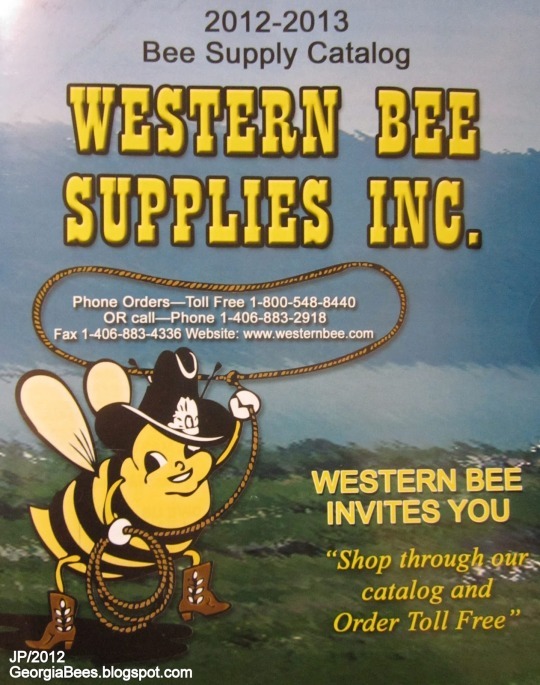
Beekeepers use all kinds of fantastic tools, gadgets, and equipment. Part of the fun of beekeeping is putting your hive together and using the paraphernalia that goes with it. The makings for a beehive come in a kit form and are pre-cut to make assembly easy. The work is neither difficult, nor does it require too much skill. Some suppliers will even assemble the kits for you.

Honey bee hive manufacturers traditionally make their woodenware out of pine and/or cypress. Hardwoods are too expensive for most hobbyists, and rarely seen in catalogs. A standard pine or cypress hive will cost about $100 to $150.
Any of this stuff is available from beekeeping supply stores. Most of these vendors are on the Web. Remember that shipping will drive up the cost significantly. Strongly consider purchasing from local suppliers, and/or purchase some items through Amazon Prime.
Don’t wait until the last minute to order your first startup kit. Springtime is the beginning of the beekeeping season. If you wait until spring to order your kit, you will likely have to wait to get it (the suppliers become swamped with orders at that time). Ideally it’s best to get all the stuff you need a few months before you plan to start your hive.
Many suppliers offer a basic startup kit that takes the guesswork out of what you need to get. These kits often are priced to save a few bucks. Make certain that your kit contains these basic items:
Bottom board
Lower hive body (deep) with frames and foundation
Honey super (shallow or medium) with frames and foundation
Inner and outer covers
Hardware to assemble stuff (various size nails, foundations pins, and so on)
Veil and gloves
Smoker
Hive tool


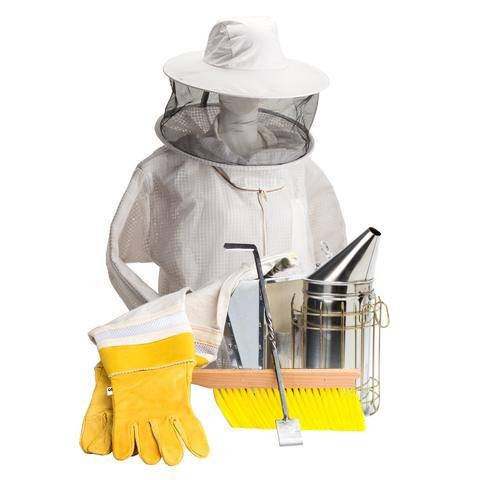

8-Frame Kit10-Frame KitComparing 8-Frame vs. 10-Frame Hives.
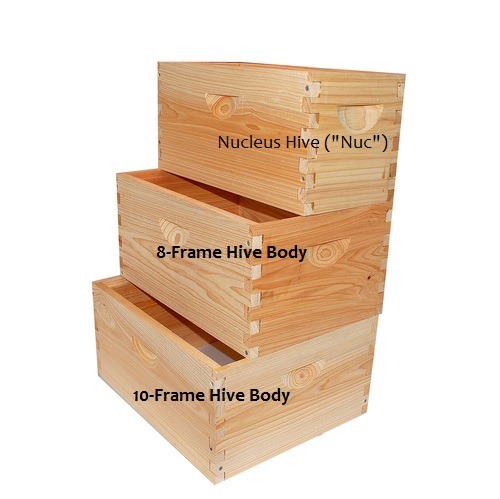
8-frame hives have been in use for over 100 years and are again increasing in popularity. Some components like the frames are interchangeable between 8- or 10-frame hives, but other parts like supers will fit one size hive or the other. 8-frames hives are lighter and easier to handle than 10-frame hives.10 Frame is the more common sized hive used in the US over the last several decades. This hive is compatible with the majority of hives/hive components in use today. Being larger obviously allows more room for bees and honey to be contained within a single hive. A medium super loaded with honey will weigh 40 to 50 lbs. A deep hive body full of bees, brood, and honey should weigh about 80 lbs. So, a single 10-frame hive might weigh 130 lbs.
National Beekeeping Suppliers (in no particular order):
https://www.dadant.com/
http://www.blueskybeesupply.com/
https://www.kelleybees.com/
https://www.brushymountainbeefarm.com/
https://www.mannlakeltd.com/
https://www.pigeonmountaintrading.com/
https://www.gabees.com/
http://westernbee.com/
Local Suppliers:
http://www.morganhoney.com/
http://www.flippinbeecompany.com/
https://www.facebook.com/Maddox-Feed-And-Seed-206927249342042/
https://www.southernstates.com/storelocations/46239/index.aspx/
http://www.blueridgehoneycompany.com/
http://www.jarrettbees.com/
http://www.athenabee.com/
0 notes
Text
How to Obtain Your Bee Colony
Where do the bees come from? You have several different options when it comes to obtaining your bees. Some are good; others are not so good. Here are some bee-ordering options and their benefits or drawbacks.
Ordering package bees
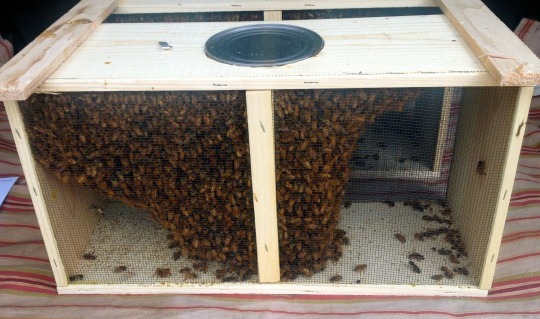
One of your better options and by far the most popular way to start a new hive is to order package bees. You can order bees by the pound from a reputable supplier. Bee breeders are found mostly in the southern states. They will ship just about anywhere in the continental United States.
A package of bees and a single queen are shipped in a small wooden box with two screened sides. Packaged bees are sent via U.S. Mail. A package of bees is about the size of a large shoebox and includes a small, screened cage for the queen (about the size of a matchbook) and a tin can of sugar syrup that serves to feed the bees during their journey. A three-pound package of bees contains about 10,000 bees, the ideal size for you to order. Order one package of bees for each hive that you plan to start.
Package bees are shipped in screened boxes. Note the feeding can and queen cage.
Buying a Nucleus (“nuc”) bee colony
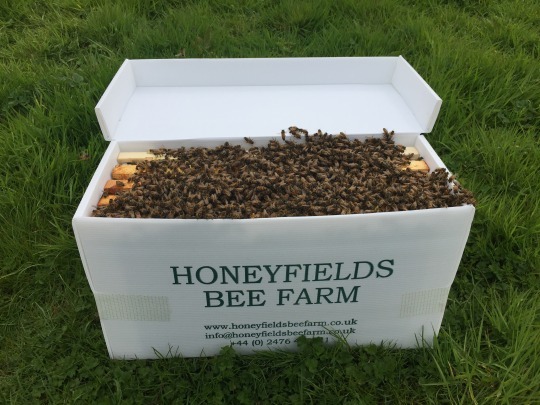
Another good option for the new beekeeper is to find a local beekeeper who can sell you a nucleus (nuc) colony of bees. A nuc consists of four to five frames of brood and bees, plus an actively laying queen. All you do is transfer the frames (bees and all) from the nuc box into your own hive. The box usually goes back to the supplier.
If you can find a local source of bees, it’s far less stressful for the bees (they don’t have to go through the mail system). You can also be reasonably sure that the bees will do well in your geographic area, and having a local supplier gives you a convenient place to go when you have beekeeping questions (your own neighborhood bee mentor).
A nuc or nucleus consists of a small wooden or cardboard hive with three to five frames of brood and bees, plus a young queen.
A standard wooden 5-frame nuc box.
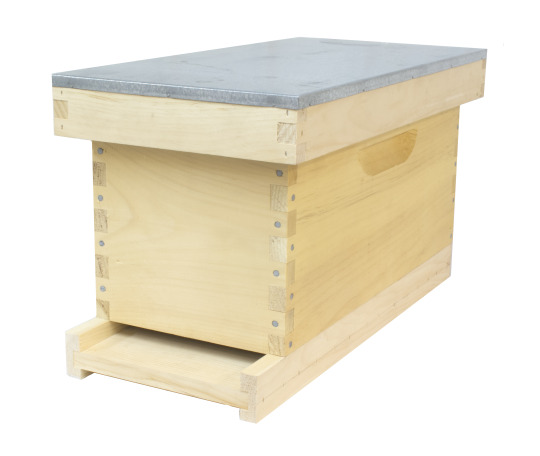
Purchasing an established colony
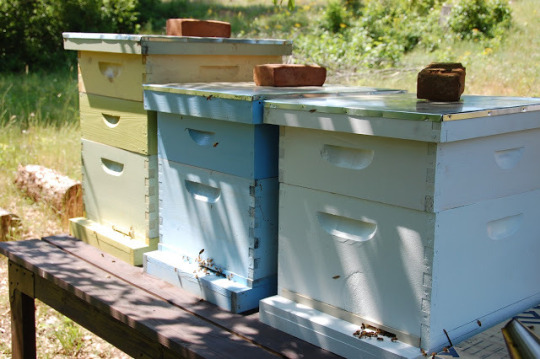
While not a common method of getting started, you may find a local beekeeper who’s willing to sell you a fully established colony of bees. This may sound easy, but it can be challenging for a new beekeeper. First, you encounter many more bees to deal with than just getting a package or nuc. And the bees are mature and well established in their hive. They tend to be more protective of their hive than a newly established colony (you’re more likely to get stung). Their sheer volume makes inspecting the hive a challenge. Furthermore, old equipment may be harder to manipulate (things tend to get glued together with propolis after the first season). More important, you also lose the opportunity to discover some of the experiences of beekeeping that you only have when starting a hive from scratch: the building of new comb, introducing a new queen, and witnessing the development of a new colony.
Capturing a wild swarm of bees
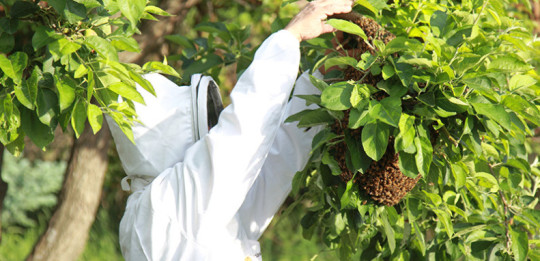
Here’s an option where the price is free. Capturing a wild swarm is a bit tricky for someone who never has handled bees. And you never can be sure of the health, genetics, and temperament of a wild swarm. However, what an opportunity to discover some of the experiences of beekeeping … If you can get a beekeeper with experience in capturing swarms to help you, I recommend giving it a try.
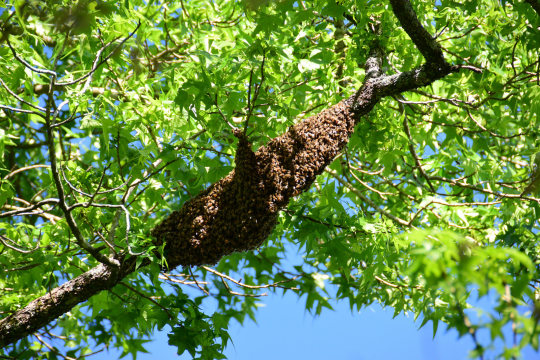
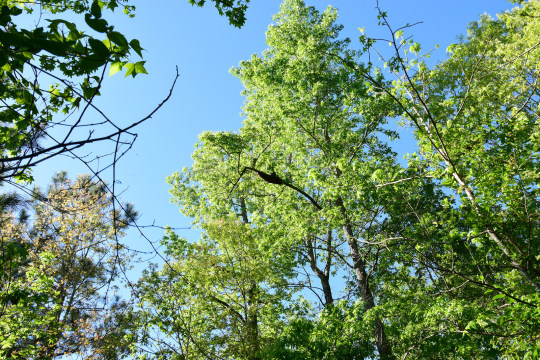
0 notes
Text
How to Identify the Three Castes of Bees
Three different castes (worker, queen, and drone) make up the total population of a bee hive. Each has its own characteristics, roles, and responsibilities. Upon closer examination, the three types of bees even look a little different, and being able to distinguish one from the other is important.
Her majesty, the queen bee
The queen bee is the heart and soul of the colony. She is the reason for nearly everything the rest of the colony does. The queen is the only bee without which the rest of the colony cannot survive. A good quality queen means a strong and productive hive.
Only one queen lives in a given hive. She is the largest bee in the colony, with a long and graceful body. She is the only female with fully developed ovaries. The queen’s two primary purposes are to produce chemical scents that help regulate the unity of the colony and to lay LOTS of eggs. She is capable of producing more than 1,500 eggs a day at 30-second intervals. That many eggs are more than her body weight!
The worker bee
The majority of the hive’s population consists of worker bees. Like the queen, worker bees are all female. Workers are smaller than the queen, their abdomens are shorter, and on their hind legs they possess pollen baskets, which are used to tote pollen back from the field.
Like the queen, the worker bee has a stinger. But her stinger is not a smooth syringe like the queen’s. It has a barb on the end. The barb causes the stinger, venom sack, and a large part of the bee’s gut to remain in a human victim. Only in mammals does the bee’s stinger get stuck. The bee can sting other insects again and again while defending its home.
The drone bee
The only male bee in the colony, drones make up a relatively small percentage of the hive’s total population. At the peak of the season their numbers may be only in the hundreds. You rarely find more than a thousand.
New beekeepers often mistake a drone for the queen, because he is larger and stouter than a worker bee. But his shape is in fact more like a barrel (the queen’s shape is thinner, more delicate and tapered). The drone’s eyes are huge and seem to cover his entire head. He doesn’t forage for food from flowers, and he has no pollen baskets. He doesn’t help with the building of comb, because he has no wax-producing glands. Nor can the drone bee help defend the hive — he has no stinger and can be handled by the beekeeper with absolute confidence.
An organ inside the queen called the “spermatheca” is the receptacle for the sperm. The queen will mate with several drones during her nuptial flight. After mating with the queen, the drone’s most personal apparatus is torn away, and it falls to its death.
0 notes
Text
Where to Locate Your Hives
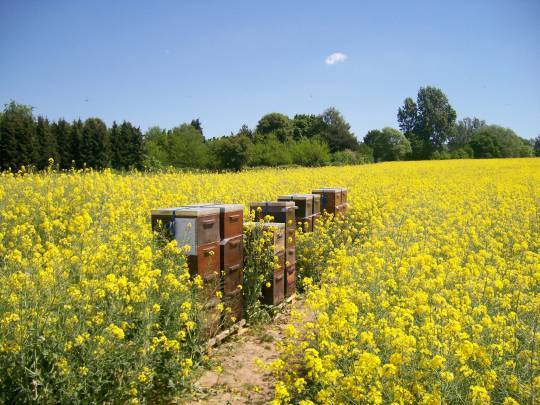
You can keep honey bees just about anywhere: in the countryside, in the city, in a corner of the garden, by the back door, in a field, on the terrace, or even on an urban rooftop. You don’t need a great deal of space, nor do you need to have flowers on your property. Bees will happily travel for miles to forage for what they need.
You’ll get optimum results if you follow some fundamental guidelines.
Basically, you’re looking for easy access (so you can tend to your hives), good drainage (so the bees don’t get wet), a nearby water source for the bees, plenty of sunlight, and minimal wind. Keep in mind that fulfilling all these criteria may not be possible. Do the best you can by…
Facing your hive to the southeast. That way your bees get early morning sun and start foraging early.
Positioning your hive so that it is easily accessible come honey harvest time.
Providing a windbreak at the rear of the hive. You can plant trees, stack hay bales, or erect a fence made from posts and burlap, blocking harsh winter winds that can stress the colony.
Putting the hive in direct sunlight. Ideally, late afternoon/evening shade is beneficial, but avoid deep, dark shade, because it can make the hive damp and the colony listless.
Making sure the hive has good ventilation. Avoid placing it in a gully where the air is still and damp. Also, avoid putting it at the peak of a hill, where the bees will be subjected harsh winds.
Placing the hive absolutely level from side to side, and with the front of the hive just slightly lower than the rear (a difference of an inch or less is fine), so that any rainwater drains out of the hive.
Locating your hive on firm, dry land. Mulch around the hive prevents grass and weeds from blocking its entrances.
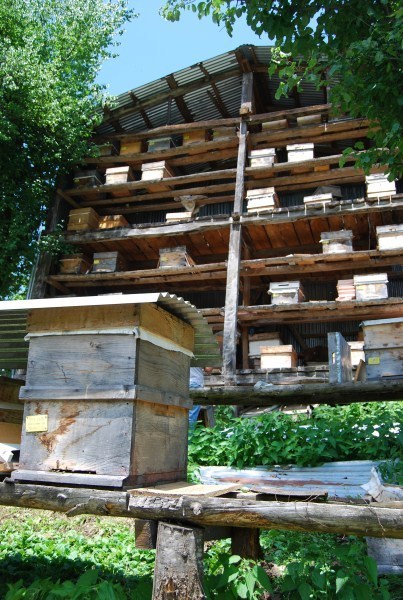
1 note
·
View note
